Some Features of Modeling Ultrasound Propagation in Non-Destructive Control of Metal Structures Based on the Magnetostrictive Effect
Abstract
1. Introduction
2. Materials and Methods
3. Results and Discussion
3.1. Formulation of Inverse Problems
3.2. Numerical Solution of the Obtained Models of Inverse Problems
3.3. Mathematical Model for Determining the Velocity of Propagation of Sound Waves in Solids
3.4. Comparative Analysis
4. Conclusions
Author Contributions
Funding
Data Availability Statement
Acknowledgments
Conflicts of Interest
References
- Suchocki, C.; Błaszczak-Bąk, W. Down-Sampling of Point Clouds for the Technical Diagnostics of Buildings and Structures. Geosciences 2019, 9, 70. [Google Scholar] [CrossRef]
- Sogomonyan, V.K.; Chibukhchyan, G.S.; Chibukhchyan, O.S. Diagnostics of fatigue fractures of building structures elements. Mag. Civ. Eng. 2018, 82, 195–203. [Google Scholar]
- Bondarenko, Y.; Kovalchuk, O.; Loginova, Y.; Artiukh, K. Risk analysis on technical safety of production of welded structures using non-destructive test and technical diagnostics. Technol. Audit. Prod. Reserv. 2019, 6, 36–41. [Google Scholar] [CrossRef]
- Wu, S.; Clements-Croome, D.; Fairey, V.; Albany, B.; Sidhu, J.; Desmond, D.; Neale, K. Reliability in the whole life cycle of building systems. Eng. Constr. Arch. Manag. 2006, 13, 136–153. [Google Scholar] [CrossRef]
- Kuzina, E.; Rimshin, V.; Kurbatov, V. The Reliability of Building Structures Against Power and Environmental Degradation Effects. IOP Conf. Ser. Mater. Sci. Eng. 2018, 463, 042009. [Google Scholar] [CrossRef]
- Poduval’Tsev, V.V.; Khlystunov, M.S.; Mogilyuk, Z.G. Reliability of the Results of Dynamic Inspections of Buildings and Structures. Meas. Tech. 2013, 56, 846–849. [Google Scholar] [CrossRef]
- Steenbergen, R.D.J.M.; Sýkora, M.; Diamantidis, D.D.; Holický, M.; Vrouwenvelder, I.T. Economic and human safety reliability levels for existing structures. Struct. Concr. 2015, 16, 323–332. [Google Scholar] [CrossRef]
- Babak, V.P.; Babak, S.V.; Myslovych, M.V.; Zaporozhets, A.O.; Zvaritch, V.M. Principles of Construction of Systems for Diagnosing the Energy Equipment. In Diagnostic Systems For Energy Equipments; Springer: Cham, Switzerland, 2020; pp. 1–22. [Google Scholar] [CrossRef]
- Babak, V.P.; Dekusha, O.; Kovtun, S.; Ivanov, S. Information-Measuring System for Monitoring Thermal Resistance. CEUR Workshop Proc. 2019, 2387, 102–110. [Google Scholar]
- Kim, W.; Katipamula, S. A review of fault detection and diagnostics methods for building systems. Sci. Technol. Built Environ. 2017, 24, 3–21. [Google Scholar] [CrossRef]
- Kylili, A.; Fokaides, P.A.; Christou, P.; Kalogirou, S.A. Infrared thermography (IRT) applications for building diagnostics: A review. Appl. Energy 2014, 134, 531–549. [Google Scholar] [CrossRef]
- Hoła, J.; Schabowicz, K. State-of-the-art non-destructive methods for diagnostic testing of building structures – anticipated development trends. Arch. Civ. Mech. Eng. 2010, 10, 5–18. [Google Scholar] [CrossRef]
- Gao, Z.; Cecati, C.; Ding, S.X. A Survey of Fault Diagnosis and Fault-Tolerant Techniques—Part I: Fault Diagnosis With Model-Based and Signal-Based Approaches. IEEE Trans. Ind. Electron. 2015, 62, 3757–3767. [Google Scholar] [CrossRef]
- Fukumoto, A. The application of piezoelectric ceramics in diagnostic ultrasound transducers. Ferroelectrics 1982, 40, 217–230. [Google Scholar] [CrossRef]
- Martin, K.H.; Lindsey, B.D.; Ma, J.; Lee, M.; Li, S.; Foster, F.S.; Jiang, X.; Dayton, P.A. Dual-Frequency Piezoelectric Transducers for Contrast Enhanced Ultrasound Imaging. Sensors 2014, 14, 20825–20842. [Google Scholar] [CrossRef] [PubMed]
- Choi, H. Prelinearized Class-B Power Amplifier for Piezoelectric Transducers and Portable Ultrasound Systems. Sensors 2019, 19, 287. [Google Scholar] [CrossRef] [PubMed]
- Ryu, J.; Priya, S.; Uchino, K.; Kim, H.-E. Magnetoelectric Effect in Composites of Magnetostrictive and Piezoelectric Materials. J. Electroceramics 2002, 8, 107–119. [Google Scholar] [CrossRef]
- Dong, S.; Li, J.F.; Viehland, D.; Cheng, J.; Cross, L.E. A strong magnetoelectric voltage gain effect in magnetostrictive-piezoelectric composite. Appl. Phys. Lett. 2004, 85, 3534–3536. [Google Scholar] [CrossRef]
- Bogachev, I.V.; Meleshchenko, L.V. Improvement of Main Parameters of Magnetostrictive Transducers. Tech. Diagn. Non-Destr. Test. 2017, 4, 42–45. [Google Scholar] [CrossRef]
- Liu, Z.; Zhao, J.; Wu, B.; Zhang, Y.; He, C. Configuration optimization of magnetostrictive transducers for longitudinal guided wave inspection in seven-wire steel strands. NDT Int. 2010, 43, 484–492. [Google Scholar] [CrossRef]
- Kim, Y.Y.; Kwon, Y.E. Review of magnetostrictive patch transducers and applications in ultrasonic nondestructive testing of waveguides. Ultrasonics 2015, 62, 3–19. [Google Scholar] [CrossRef]
- Ashish, A.J.; Rajagopal, P.; Balasubramaniam, K.; Kumar, A.; Rao, B.P.; Jayakumar, T. Bulk ultrasonic NDE of metallic components at high temperature using magnetostrictive transducers. AIP Conf. Proc. 2017, 1806, 50010. [Google Scholar] [CrossRef]
- Golovnya, B.; Khaidurov, V. Some high-speed methods for solving nonlinear inverse heat conduction problems. Cherkasy Univ.Bull. Appl. Math. Inform. 2017, 1–2, 71–90. [Google Scholar]
- Golovnya, B.P.; Khaidurov, V.V. Effective method for solving nonlinear inverse heat conduction problem. Cherkasy Univ. Bull. Appl. Math. Inform. 2014, 18, 87–98. [Google Scholar]
- Khaidurov, V. Nonlinear mathematical model for determining the geometric position of point signals in homogeneous materials. In Proceedings of the X International Scientific and Practical Conference “Scientific Achievements of Modern Society”, Liverpool, UK, 27–29 May 2020; pp. 96–100. [Google Scholar]
- Kazakov, V.V.; Sutin, A.M. Pulsed Sounding of Cracks with the Use of the Modulation of Ultrasound by Vibrations. Acoust. Phys. 2001, 47, 308–312. [Google Scholar] [CrossRef]
- Zhang, J.; Drinkwater, B.W.; Wilcox, P.D. Longitudinal wave scattering from rough crack-like defects. IEEE Trans. Ultrason. Ferroelectr. Freq. Control. 2011, 58, 2171–2180. [Google Scholar] [CrossRef] [PubMed]
- Babak, V.; Eremenko, V.; Zaporozhets, A. Research of diagnostic parameters of composite materials using johnson distribution. Int. J. Comput. 2019, 483–494. [Google Scholar] [CrossRef]
- Eremenko, V.; Zaporozhets, A.; Babak, V.; Isaienko, V.; Babikova, K. Using Hilbert Transform in Diagnostic of Composite Materials by Impedance Method. Period. Polytech. Electr. Eng. Comput. Sci. 2020, 64, 334–342. [Google Scholar] [CrossRef]
- Uhlmann, G. Inverse problems: Seeing the unseen. Bull. Math. Sci. 2014, 4, 209–279. [Google Scholar] [CrossRef]
- Bazulin, E.G.; Goncharsky, A.V.; Romanov, S.Y.; Seryozhnikov, S.Y. Parallel CPU- and GPU-Algorithms for Inverse Problems in Nondestructive Testing. Lobachevskii J. Math. 2018, 39, 486–493. [Google Scholar] [CrossRef]
- Zaporozhets, A.O.; Khaidurov, V.V. Mathematical Models of Inverse Problems for Finding the Main Characteristics of Air Pollution Sources. Water, Air Soil Pollut. 2020, 231, 563. [Google Scholar] [CrossRef]
- Bilicz, S. Sensitivity analysis of inverse problems in EM non-destructive testing. IET Sci. Meas. Technol. 2020, 14, 543–551. [Google Scholar] [CrossRef]
- Li, Z.; Haigh, A.; Soutis, C.; Gibson, A.; Sloan, R. A Simulation-Assisted Non-destructive Approach for Permittivity Measurement Using an Open-Ended Microwave Waveguide. J. Nondestruct. Eval. 2018, 37, 39. [Google Scholar] [CrossRef]
- Yacef, N.; Bouden, T.; Grimes, M. Accurate ultrasonic measurement technique for crack sizing using envelope detection and differential evolution. NDT Int. 2019, 102, 161–168. [Google Scholar] [CrossRef]
- Babak, V.P.; Babak, S.V.; Myslovych, M.V.; Zaporozhets, A.O.; Zvaritch, V.M. Simulation and Software for Diagnostic Systems. In Diagnostic Systems For Energy Equipments; Springer: Cham, Switzerland, 2020; pp. 71–90. [Google Scholar] [CrossRef]
- Babak, V.P.; Babak, S.V.; Myslovych, M.V.; Zaporozhets, A.O.; Zvaritch, V.M. Technical Provision of Diagnostic Systems. In Diagnostic Systems For Energy Equipments; Springer: Cham, Switzerland, 2020; pp. 91–133. [Google Scholar] [CrossRef]
- Larsson, S.; Thomee, V. Partial Differential Equations with Numerical Methods; Springer: Berlin/Heidelberg, Germany; New York, NY, USA, 2003. [Google Scholar]
- Marquardt, W. Model-Based Experimental Analysis of Kinetic Phenomena in Multi-Phase Reactive Systems. Chem. Eng. Res. Des. 2005, 83, 561–573. [Google Scholar] [CrossRef]
- Carita Montero, R.; Roberty, N.; Silva Neto, A. Absorption coefficient estimation in heterogeneous media using a domain partition consistent with divergent beams. Inverse Probl. Eng. 2001, 9, 587–617. [Google Scholar] [CrossRef]
- Engel, M. A Multigrid Method for the Effcient Numerical Solution of Optimization Problems Constrained by Partial Differential Equations. Doctoral Dissertation, University of Bonn, Bonn, Germany, 2009. [Google Scholar]
- Engel, M. A Newton-Multigrid Method for PDE Constrained Optimization. In Proceedings of the Workshop on PDE Constrained Optimization, Hamburg, Germany, 27–29 March 2008. [Google Scholar]
- Hackbusch, W. Iterative Solution of Large Sparse Systems of Equations. In Applied Mathematical Sciences; Springer: New York, NY, USA, 1994. [Google Scholar]
- Keskin, Y.; Oturanc, G. Reduced differential transform method for partial differential equations. Int. J. Nonlinear Sci. Numer. Simul. 2009, 10, 741–749. [Google Scholar] [CrossRef]
- Alvarez Acevedo, N.; Roberty, N.; Silva Neto, A. An explicit formulation for the inverse transport problem using only external detectors. Computational modelling. Part I Comput. Appl. Math. 2010, 29, 343–358. [Google Scholar] [CrossRef]
- Baranov, V.; Zasyad’ko, A.; Frolov, G. Integrodifferential method of solving the inverse coefficient heat conduction problem. J. Eng. Phys. 2010, 83, 60–71. [Google Scholar]
- Barbone, P.; Oberai, A.; Harari, I.; Albocher, P. Adjoint-weighted variational formulation for a direct computational solution of an inverse heat conduction problem. USA J. Inverse Probl. 2007, 6, 2325–2342. [Google Scholar] [CrossRef]
- Qian, A.-L. Identifying an unknown source in the Poisson equation by a wavelet dual least square method. Bound. Value Probl. 2013, 2013, 267. [Google Scholar] [CrossRef]
- Saad, Y. Iterative Methods for Sparse Linear Systems, 2nd ed.; SIAM: Philadelphia, PA, USA, 2003. [Google Scholar]
- Nguyen, P.; Nguyen, L. A numerical method for an inverse source problem for parabolic equations and its application to a coefficient inverse problem. J. Inverse Ill-Posed Probl. 2020, 28, 323–339. [Google Scholar] [CrossRef]
- Bohachev, I.; Babak, V.; Zaporozhets, A. Novel small-aperture transducers based on magnetostrictive effect for diagnostic systems. Tekhnichna Elektrodynamika 2022, 2022, 69–78. [Google Scholar] [CrossRef]
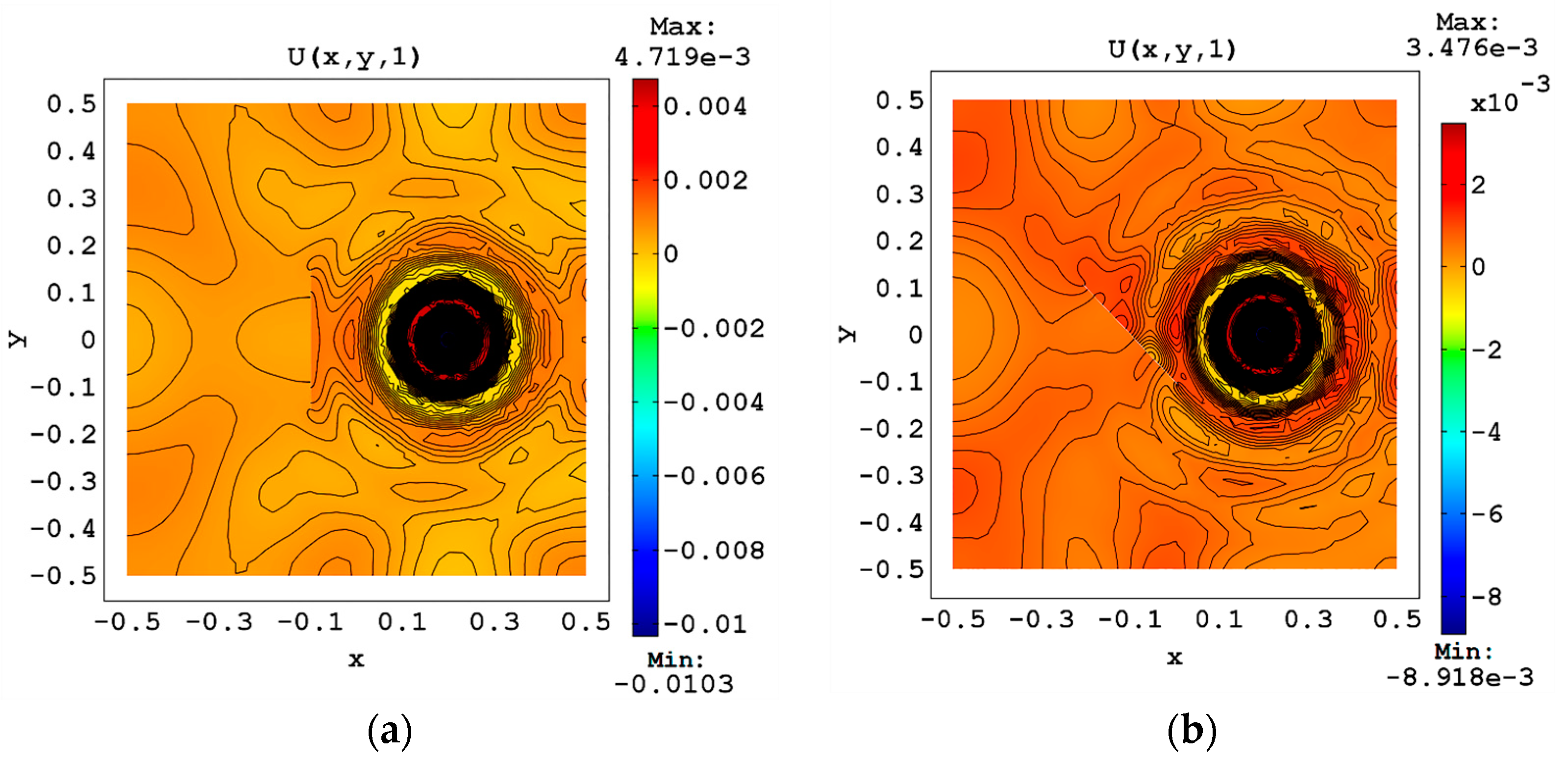



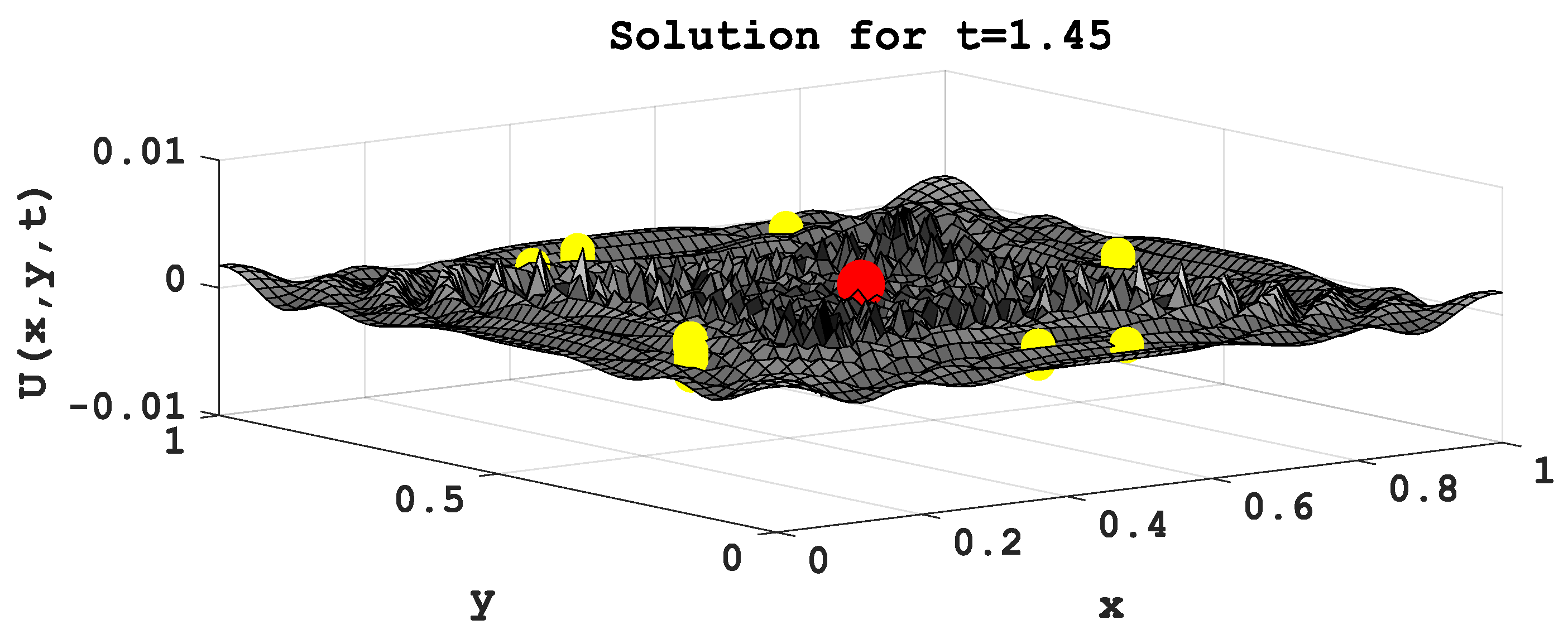
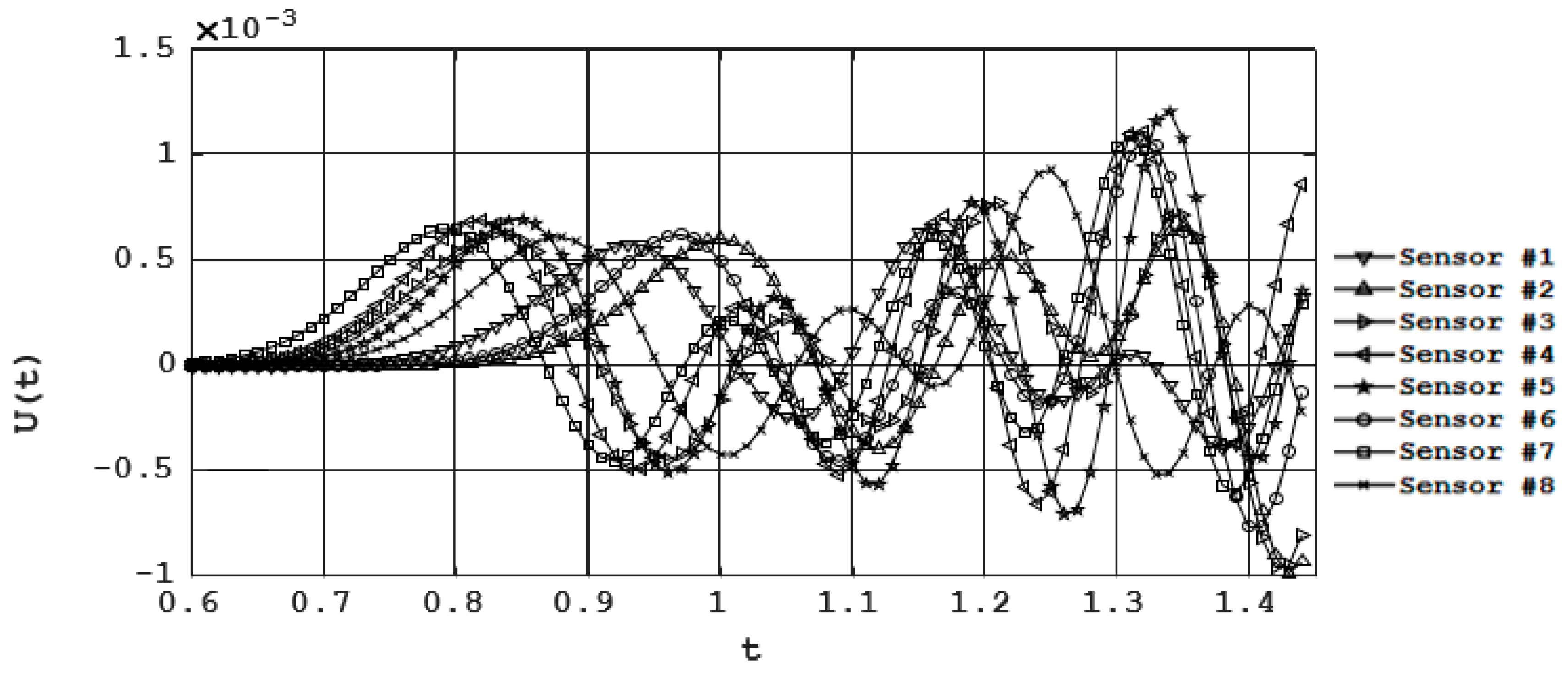
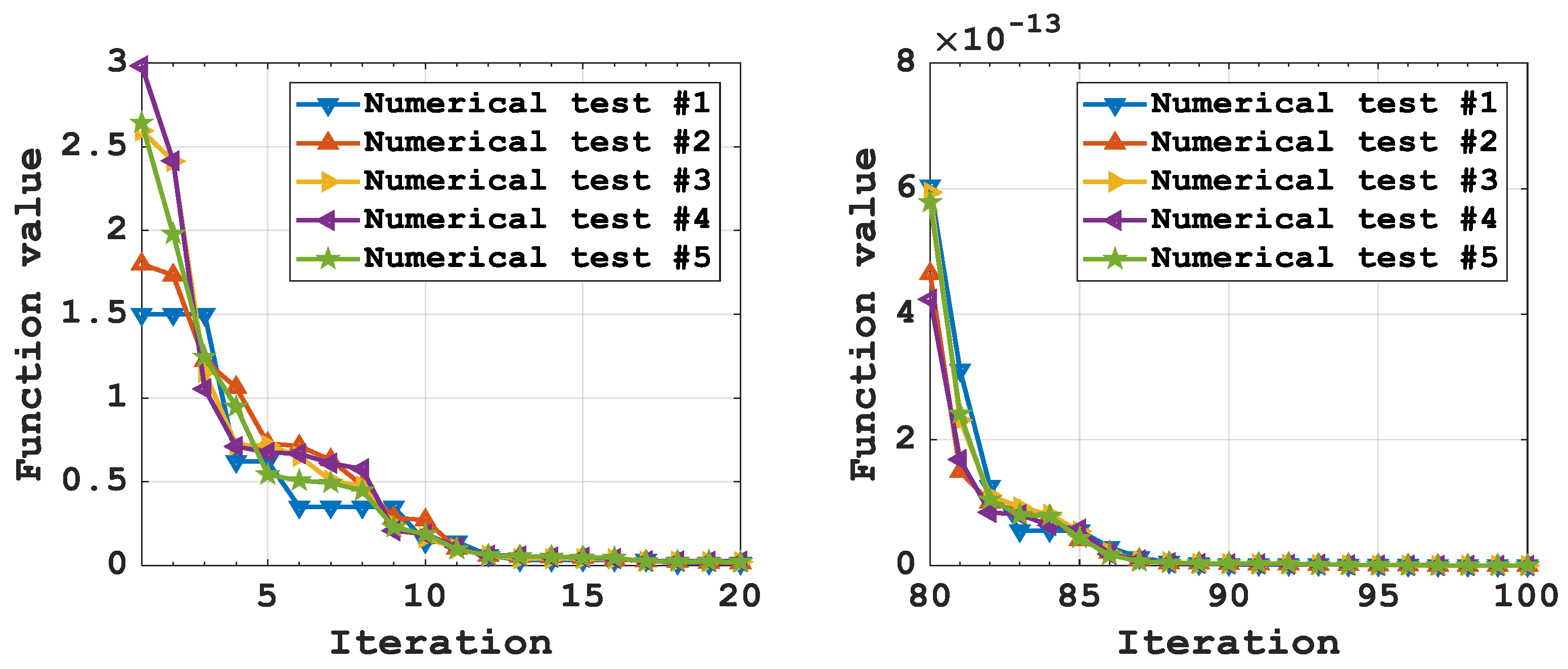

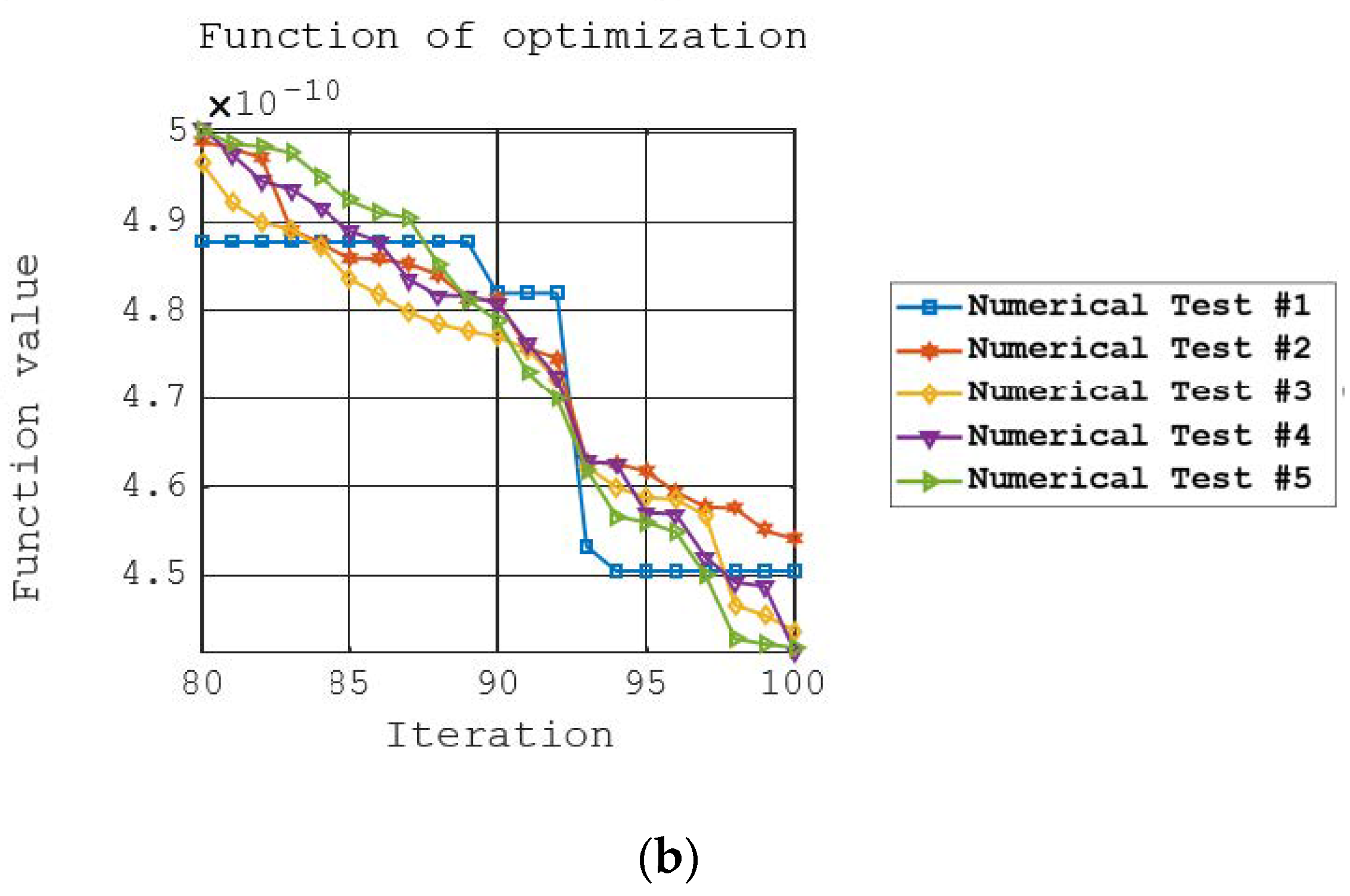
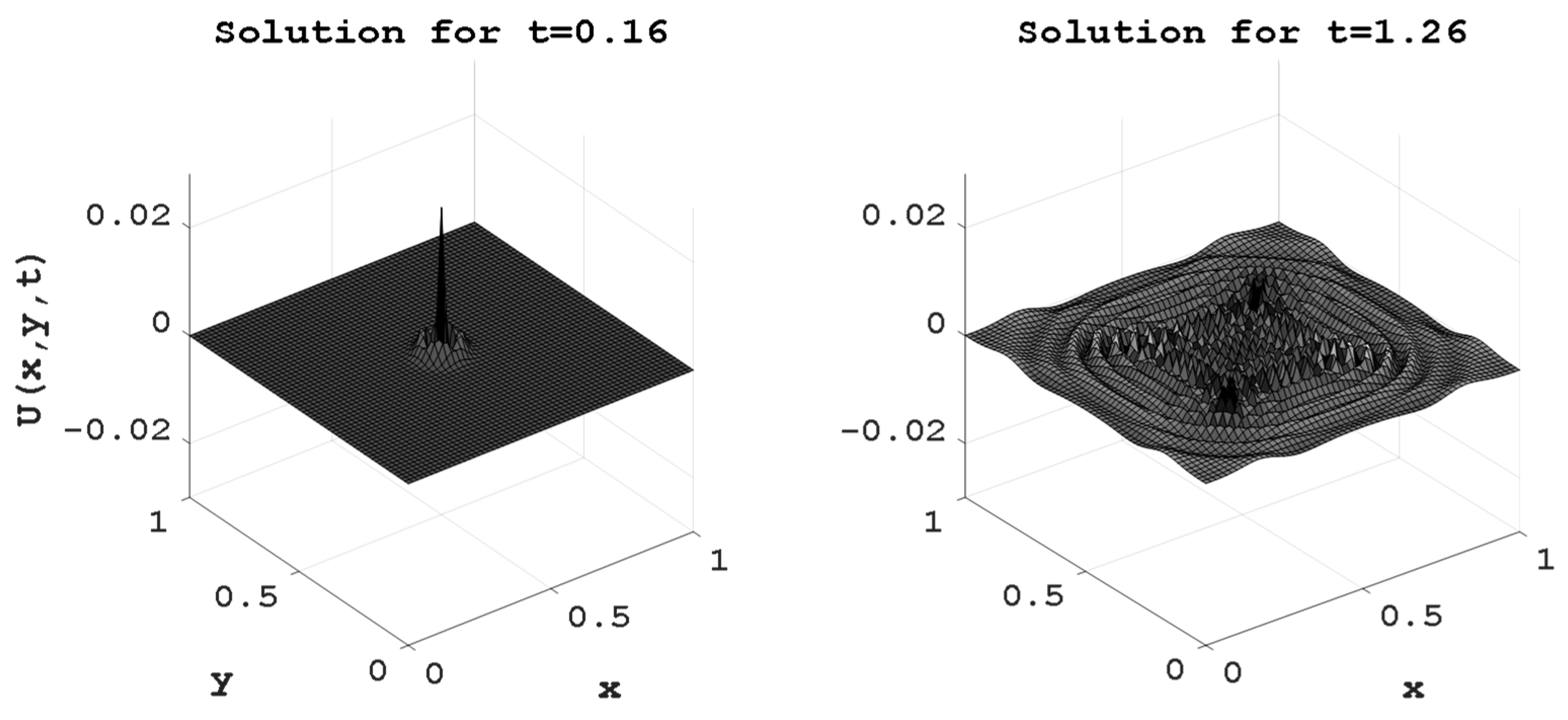

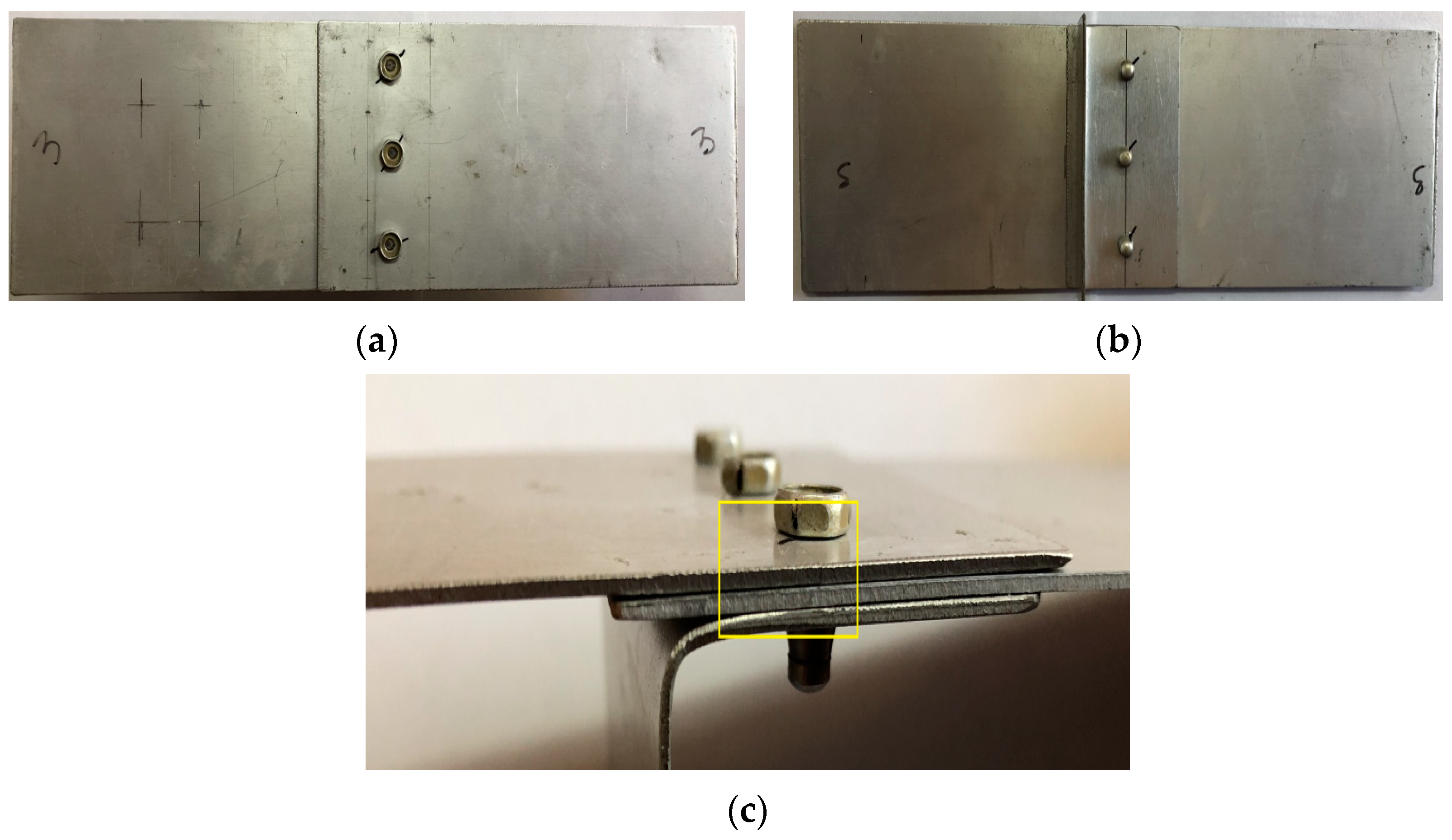


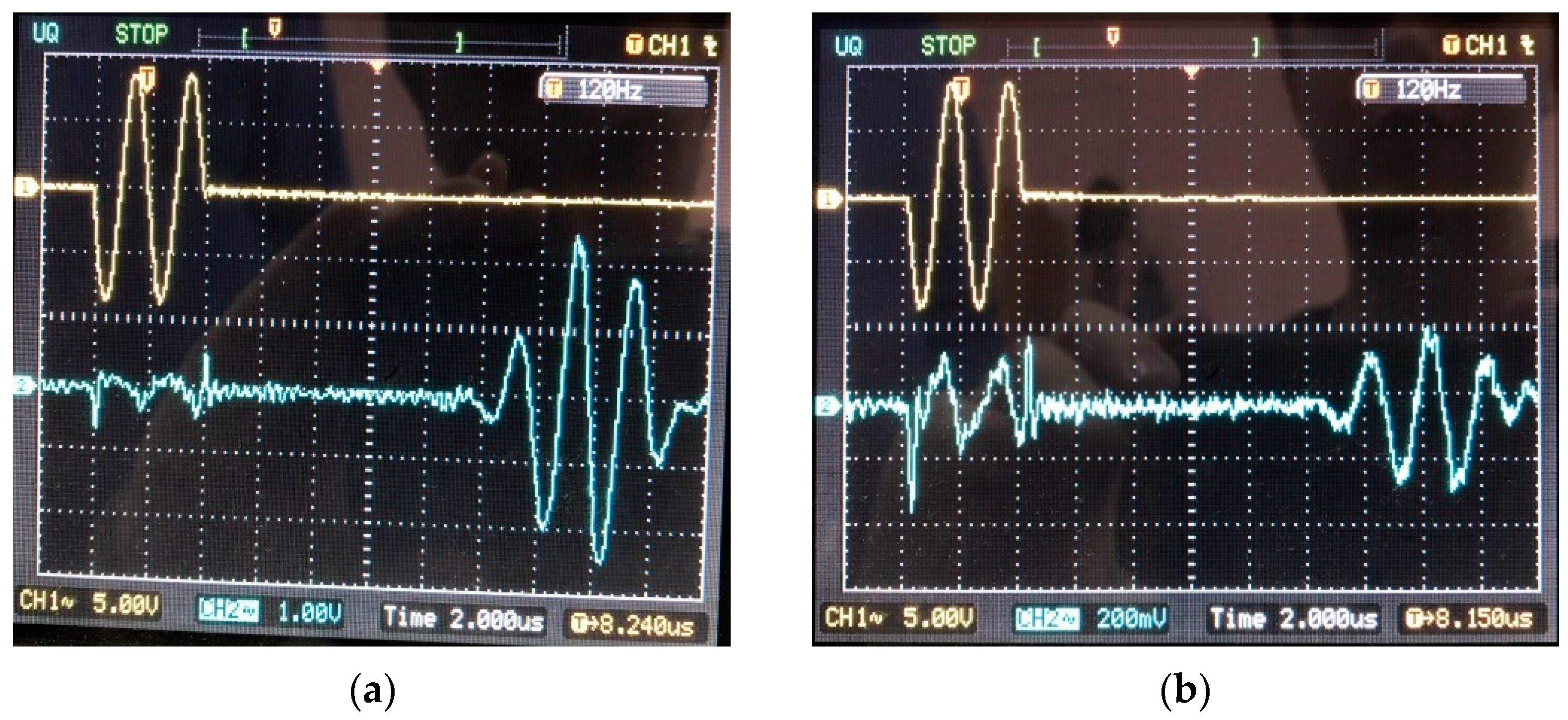



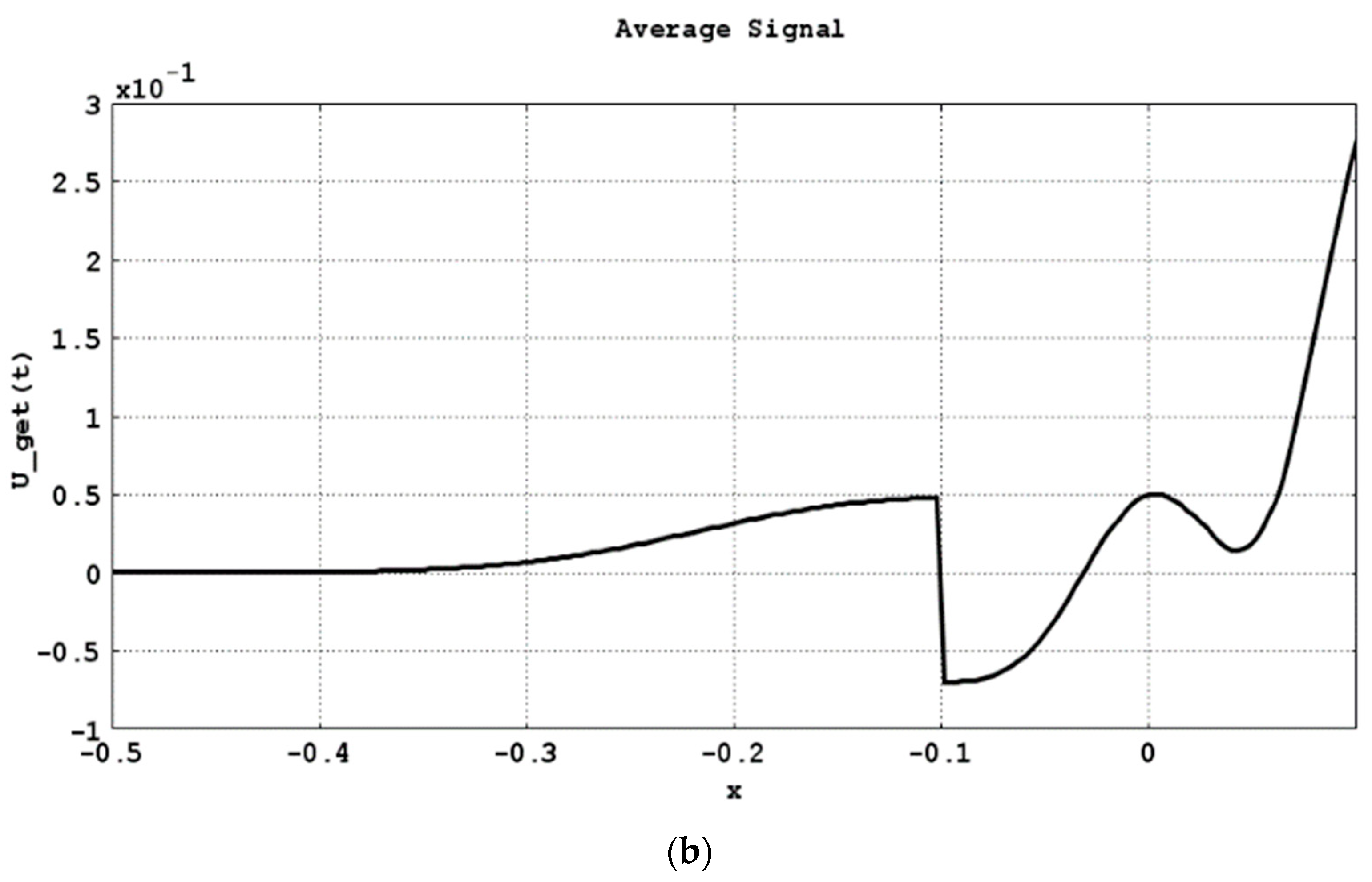
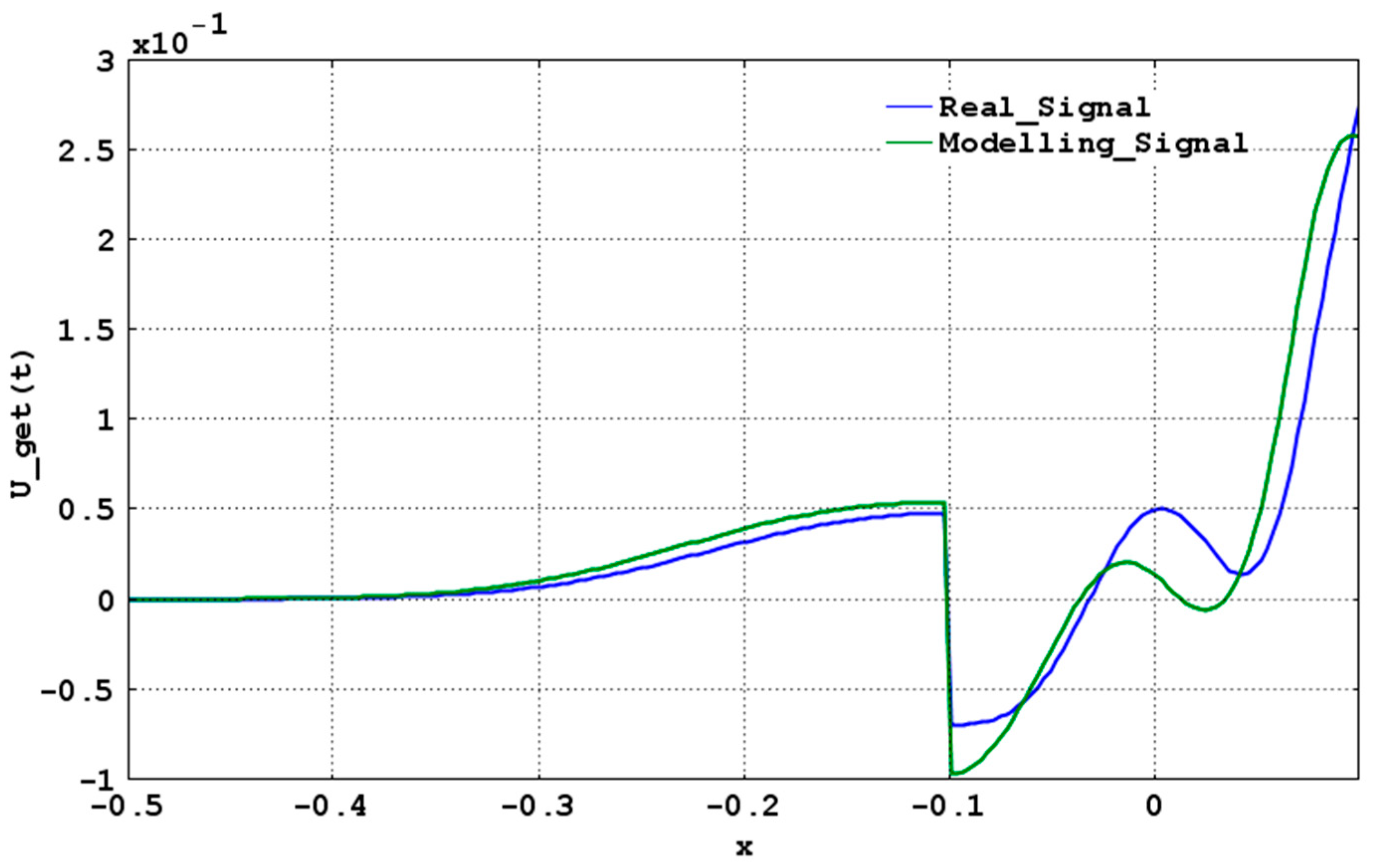
| Coordinate | Point 1 | Point 2 | Point 3 | Point 4 | Point 5 | Point 6 | Point 6 | Point 8 |
|---|---|---|---|---|---|---|---|---|
| xi | 0.5333 | 0.7167 | 0.4500 | 0.1500 | 0.3167 | 0.1000 | 0.8667 | 0.4167 |
| yi | 0.0667 | 0.9167 | 0.1167 | 0.3500 | 0.8500 | 0.2833 | 0.5167 | 0.9000 |
| Iteration | Value (21) | Iteration | Value (21) |
|---|---|---|---|
| 1 | 4.05116296 × 10−5 | 70 | 1.78558303 × 10−13 |
| 5 | 2.43795886 × 10−5 | 75 | 1.04036629 × 10−13 |
| 10 | 1.39653308 × 10−5 | 80 | 6.67451567 × 10−14 |
| 15 | 7.86654197 × 10−6 | 85 | 3.71148666 × 10−14 |
| 20 | 4.37072926 × 10−6 | 90 | 2.18322134 × 10−14 |
| 25 | 2.78290865 × 10−6 | 100 | 1.21550930 × 10−14 |
| Radio Pulse Filling Frequency, MHz | 0.1…10.0 |
|---|---|
| Pulse duration | 1…16 periods of filling oscillation |
| Amplitude value of voltage on emitters, V | 0…10 at load 0.5 OM |
| Input impedance, kOhm | >3.0 |
| Maximum output voltage, V | 10 |
| Amplification coefficient | 4000 |
| Parameter | Defect-Free Area | Area with Crack |
|---|---|---|
| t, s | 13.6·10−6 | 14.4·10−6 |
| 2Um, V | 5 | 0.5 |
| Point | 1 | 2 | 3 | … | 998 | 999 | 1000 |
|---|---|---|---|---|---|---|---|
| Experiment 1 | 0.0475 | 0.0475 | 0.0475 | … | −0.0170 | 0.0475 | 0.0152 |
| Experiment 2 | −0.2106 | −0.2428 | −0.2428 | … | −0.2751 | −0.3074 | −0.2751 |
| Experiment 3 | −0.2106 | −0.2428 | −0.2106 | … | −0.2428 | −0.2428 | −0.2428 |
| Experiment 4 | 0.0152 | 0.0475 | 0.0475 | … | 0.0475 | 0.0152 | 0.0152 |
| Experiment 5 | 0.0798 | 0.0475 | 0.0798 | … | 0.0475 | 0.0798 | 0.0475 |
| Experiment 6 | −0.0493 | −0.0170 | −0.0170 | … | −0.0493 | −0.0815 | −0.0493 |
| Experiment 7 | 0.0152 | 0.0152 | 0.0152 | … | 0.0152 | −0.0170 | 0.0152 |
| Experiment 8 | −0.0493 | −0.0815 | −0.1138 | … | −0.0815 | −0.0815 | −0.0815 |
Disclaimer/Publisher’s Note: The statements, opinions and data contained in all publications are solely those of the individual author(s) and contributor(s) and not of MDPI and/or the editor(s). MDPI and/or the editor(s) disclaim responsibility for any injury to people or property resulting from any ideas, methods, instructions or products referred to in the content. |
© 2023 by the authors. Licensee MDPI, Basel, Switzerland. This article is an open access article distributed under the terms and conditions of the Creative Commons Attribution (CC BY) license (https://creativecommons.org/licenses/by/4.0/).
Share and Cite
Babak, V.; Bohachev, I.; Zaporozhets, A.; Khaidurov, V.; Havrysh, V.; Kalinichenko, A. Some Features of Modeling Ultrasound Propagation in Non-Destructive Control of Metal Structures Based on the Magnetostrictive Effect. Electronics 2023, 12, 477. https://doi.org/10.3390/electronics12030477
Babak V, Bohachev I, Zaporozhets A, Khaidurov V, Havrysh V, Kalinichenko A. Some Features of Modeling Ultrasound Propagation in Non-Destructive Control of Metal Structures Based on the Magnetostrictive Effect. Electronics. 2023; 12(3):477. https://doi.org/10.3390/electronics12030477
Chicago/Turabian StyleBabak, Vitalii, Ihor Bohachev, Artur Zaporozhets, Vladyslav Khaidurov, Valerii Havrysh, and Antonina Kalinichenko. 2023. "Some Features of Modeling Ultrasound Propagation in Non-Destructive Control of Metal Structures Based on the Magnetostrictive Effect" Electronics 12, no. 3: 477. https://doi.org/10.3390/electronics12030477
APA StyleBabak, V., Bohachev, I., Zaporozhets, A., Khaidurov, V., Havrysh, V., & Kalinichenko, A. (2023). Some Features of Modeling Ultrasound Propagation in Non-Destructive Control of Metal Structures Based on the Magnetostrictive Effect. Electronics, 12(3), 477. https://doi.org/10.3390/electronics12030477









